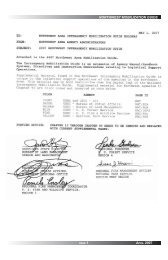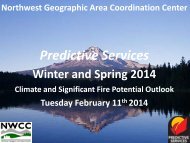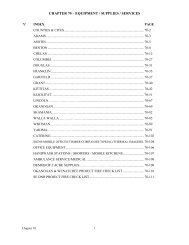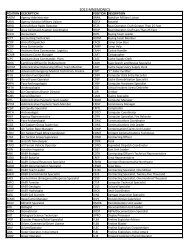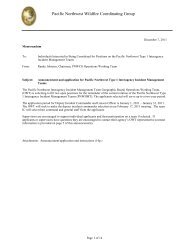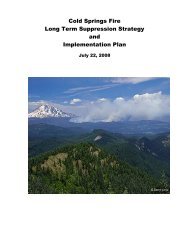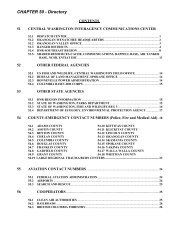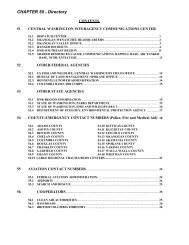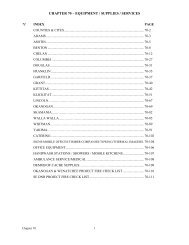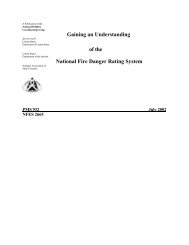Charts for interpreting wildland fire behavior characteristics - NWCC
Charts for interpreting wildland fire behavior characteristics - NWCC
Charts for interpreting wildland fire behavior characteristics - NWCC
You also want an ePaper? Increase the reach of your titles
YUMPU automatically turns print PDFs into web optimized ePapers that Google loves.
1 KEYWORDS:<br />
Andrews, Patricia L.; Rothermel, Richard C. <strong>Charts</strong> <strong>for</strong> <strong>interpreting</strong> w~ldland <strong>fire</strong><br />
<strong>behavior</strong> <strong>characteristics</strong>. Gen. Tech. Rep. INT-131. Ogden, UT: U.S.<br />
Department of Agriculture, Forest Service, Intermountain Forest and Range<br />
Experiment Station; 1981. 21 p.<br />
The <strong>fire</strong> <strong>characteristics</strong> chart is proposed as a graphical method of<br />
presenting two primary <strong>characteristics</strong> of <strong>fire</strong> <strong>behavior</strong>-spread rate and intensity.<br />
Its primary use is communicat~ng and <strong>interpreting</strong> either site-specific predictions<br />
of <strong>fire</strong> <strong>behavior</strong> or National Fire-Danger Rating System (NFDRS) indexes and<br />
components. Rate of spread, heat per unit area, flame length, and <strong>fire</strong>line<br />
intensity, are plotted on a <strong>fire</strong> <strong>behavior</strong> chart. Spread component, energy release<br />
component, and burning index are plotted on an NFDRS chart. Specific examples<br />
illustrate potential application.<br />
<strong>fire</strong> <strong>behavior</strong>, <strong>fire</strong> spread, <strong>fire</strong> intensity, <strong>fire</strong>-danger rating, National<br />
Fire-Danger Rating System !<br />
The Intermountain Station, headquarted in Ogden,<br />
Utah, is one of eight regional experiment stations charged<br />
with prov'i,ding scientific knowledge to help resource<br />
managers meet human needs and protect <strong>for</strong>est and range<br />
ecosystems.<br />
The Intermountain Station includes the States of<br />
Montana, Idaho, Utah, Nevada, and western Wyoming.<br />
About 231 million acres, or 85 percent, of the land area in<br />
the Station territory are classified as <strong>for</strong>est and rangeland.<br />
These lands include grasslands, deserts, shrublands, alpine<br />
areas, and well-stocked <strong>for</strong>ests. They supply fiber <strong>for</strong><br />
<strong>for</strong>est industries; minerals <strong>for</strong> energy and industrial<br />
development; and water <strong>for</strong> domestic and industrial con-<br />
sumption. They also provide recreation opportunities <strong>for</strong><br />
millions of visitors each year.<br />
Fi$lcj,programs and research work units of the Station<br />
are maintained-in<br />
Boise, Idaho<br />
Bbzeman, Montana (in cooperation with<br />
Montana State University)<br />
Logan, Utah (in cooperation with Utah State<br />
University)<br />
Missoula, Montana (in cooperation with the<br />
University of Montana)<br />
Moscow, Idaho (in cooperation with the<br />
University of Idaho)<br />
Provo, Utah (in cooperation with Brigham<br />
Young University)<br />
Reno, Nevada (in cooperation with the Univer-<br />
sity of Nevada)




